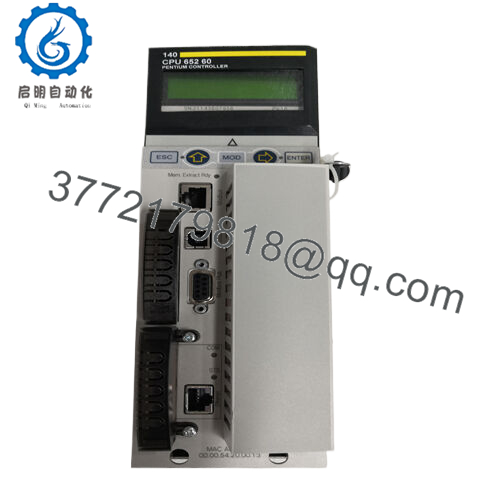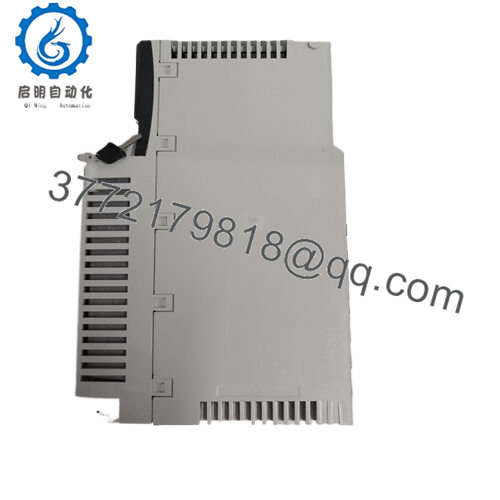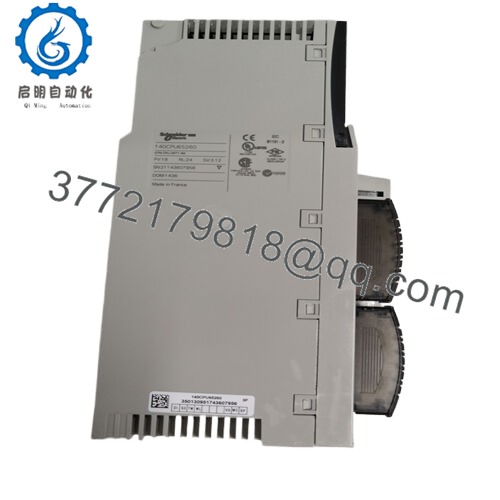Description
In the high-octane theater of industrial automation, where split-second synchronization across sprawling networks can spell the difference between seamless production and costly cascades, control specialists often tangle with the limits of legacy processors—insufficient throughput for data-intensive loops, connectivity silos that fragment diagnostics, and scalability ceilings that hamstring expansions in dynamic process control setups. Envision a sprawling logistics terminal: a central PLC juggles real-time inventory from RFID gates and AGV fleets over fiber trunks, but a sluggish CPU bottlenecks Modbus polls, delaying reroutes and stacking pallets into gridlock amid peak surges. Or in a renewable energy farm, where wind turbine arrays demand timestamped event logging for grid compliance; without robust interrupt handling, transient faults evade capture, inviting regulatory fines or blackout risks in high-reliability I/O ecosystems. These constraints bite hardest in modular architectures blending local racks with remote drops, where EMI from inverters or cable latency turns deterministic control into a dice roll, inflating MTTR and eroding ROI on capital-intensive installs. The Schneider Electric 140CPU65260 confronts this as a high-performance Unity processor for Modicon Quantum platforms, calibrated to orchestrate vast distributed networks with 266 MHz velocity and 3072 kB memory, ensuring fluid command over complex I/O signals without the drag of outdated silicon.
This processor commands respect in expansive deployments like semiconductor wafer fabs, where sub-millisecond interrupts from alignment sensors feed into 63-station drops for yield optimization, or in pharmaceutical continuous manufacturing, scaling Ethernet and Profibus modules to synchronize bioreactor feeds across cleanroom zones. Lacking such horsepower, teams graft auxiliary gateways or overclock peripherals, compounding heat, cabling, and failure vectors that bloat engineering cycles. The Schneider Electric 140CPU65260 streamlines with native support for up to two local racks and over 60 distributed stations, embedding precise time stamping and serial links for event forensics—pillars of industrial automation’s “Unity processor,” “Quantum CPU module,” and “distributed process control.” It layers redundancy via key-switch safeguards and diagnostic relays, surfacing bottlenecks before they bottleneck, not after. At bottom, it’s the conductor for symphonies where scale meets speed—fusing local logic with remote resilience, so your Quantum chassis evolves from static spine to adaptive axis in the automation continuum.
Perched at the apex of the Modicon Quantum hierarchy, the Schneider Electric 140CPU65260 reigns as the computational core, slotting into the rack’s processor bay to marshal I/O across backplanes and beyond with Pentium-grade alacrity. It draws 2760 mA at 5 VDC from redundant PSUs, firing up its 266 MHz clock to churn through 3072 kB of program/data memory—expandable to 7168 kB via PCMCIA slot—while scanning loops at rates down to 1 ms for time-critical tasks. In motion, it dispatches configuration frames over integrated Ethernet or Modbus Plus ports, polling up to 31 remote drops via fiber MBMs, with high-speed counters latching edges from encoders sans software overhead, all buffered against 500 V transients for arc-free autonomy.
- 140CPU65260
This orchestration radiates through the stack: upstream, it interfaces with HMI overlays for runtime tweaks via key-switch (run/stop/prog modes); downstream, it fans to six optional modules—Profibus DP for fieldbus daisy-chains, Sy/Max for legacy ties—prioritizing safety loops amid 63-station sprawls. Diagnostics embed deeply: bicolor LEDs signal health (green for active, red for faults), while Modbus-registers expose interrupt queues or memory parity, hookable to EcoStruxure for predictive trending. In rack-dense Quantum frames, pair it with CRA adapters for star topologies, or hot-swap under load for zero-downtime firmware flashes to V3.5+; its 50/60 Hz noise rejection and IEC-compliant EMC armor deflect substation hum, upholding 99.999% scan fidelity. For architects, it’s elegantly autonomous: insert the card, align the PCMCIA for RAM bursts, and it boots in Unity Pro, offloading cycle budgeting to the host so your process control conducts with computational clarity, not computational clutter.
| Specification | Details |
|---|---|
| Model Number | 140CPU65260 |
| Brand | Schneider Electric |
| Type | Unity Processor Module |
| Input Voltage | 5 V DC (Bus) |
| Operating Temp Range | 0°C to 60°C |
| Mounting Style | Quantum Rack |
| Dimensions | 170mm x 48mm x 280mm |
| Weight | 1.43 kg |
| Interface/Bus | Quantum Backplane, Ethernet, Modbus Plus |
| Compliance | CE, UL, RoHS |
| Supported Protocols | Ethernet, Modbus, Profibus DP, Sy/Max |
| Typical Power Draw | 2760 mA @ 5V |
Embracing the Schneider Electric 140CPU65260 cultivates a command center of computational confidence, its 266 MHz cadence sustaining 5000+ instructions per scan to untangle nested PID webs in motion control—crucial for robotic palletizers, where a 2 ms overrun cascades to misalignment and 10% rework spikes. This velocity begets systemic surety: memory partitioning isolates data tables from code, averting the 5% corruption creep in volatile apps and locking event stamps to microsecond grains for forensic audits that clear compliance hurdles at a glance.
The uplift permeates productivity; accommodating 63 drops condenses network tiers by 30%, easing topology audits and cabling economies, while interrupt ports offload edge triggers to hardware, freeing cycles for analytics that forecast motor wear from vibration trends. Engineering orbits tighten too—Unity firmware’s backdoor-patched iterations (post-V3.5) streamline migrations sans vuln scans, and redundancy hooks integrate with hot-standby pairs for SIL-3 loops without ancillary logic. Across eras, it tempers toil—MTBF eclipses 250,000 hours with no thermal throttling, redirecting techs from trace chases to throughput thrusts, where ample RAM seeds digital twins for offline rehearsals. For the Schneider Electric 140CPU65260, prowess is programmatic: it propels processes from ponderous to propulsive, where high-speed horizons harbor higher yields unhampered by hardware’s historical hesitations.
The Schneider Electric 140CPU65260 entrenches in dominions where distributed depth defines dominance, such as in aluminum smelters, where it helms anode controls over 50-drop fiber webs, its timestamping nailing arc stability amid electrolytic EMI for potency profiles that avert under-currents and critical system uptime in process control environments. Bulk material terminals invoke it for crane PLCs, scaling Profibus to remote scales amid dusty gales—high-speed counters tally loads with 1 µs edges, syncing unloaders to throughput bursts without buffer overflows.
Data center cooling plants array it for chiller ensembles, Ethernet-polling 40 stations for flow anomalies under 55°C vaults, where diagnostic relays preempt cascade failures that spike BTUs by kilowatts. These entanglements etch its eminence: from molten-metal maelstroms to metric-monitored megawatts, the Schneider Electric 140CPU65260 captains industrial automation’s computational crusade, where networked nuance nurtures net gains.
140CPU65160 – Predecessor model with 1024 kB RAM for lighter distributed loads
140CPU67160 – Hot-standby variant for redundant CPU pairings in safety-critical nets
BMEP584040 – M580 successor processor for Ethernet-native Quantum upgrades
140CPU65250 – Lower-speed 200 MHz alternative for cost-contained local racks
ASMBP20 – Fiber MBM companion for trunking remote drops in expanded topologies
140NOE77100 – Ethernet module add-on for IIoT extensions on existing CPUs
140CRP93000 – RIO repeater for chaining beyond 63 stations in legacy Quantum
BMECPU670H – High-availability M580 CPU for seamless Unity-to-EcoStruxure bridges
Before enshrining the Schneider Electric 140CPU65260 in your Quantum chassis, vet the backplane for firmware parity—V2.0 boots legacy apps, but V3.5+ mandates Copro 5.8 to seal backdoor gaps; snag the patch from Schneider’s vault and flash via PCMCIA pre-power. Slot alignment is exacting: confirm ejector leverage clears 0.2 mm offsets, as misseats spike draw beyond 3A and droop rails under load. Capacity calculus is crucial—profile your drops against 7A bus limits with Unity’s simulator, lest 60+ stations overload secondaries below 4.75 V, muting interrupts; allocate 50 mm airflow above the card in vertical stacks to cap 60°C junctions. Ground the shield braid single-point to evade loops in Ethernet stubs.
Sustaining its supremacy summons seasoned scrutiny, not spasms. Bi-weekly, interrogate the status LEDs for steady green on RUN—amber flickers cue memory parity, so cycle a self-test via key-switch to log ECC bits under 1%. Quarterly, probe PCMCIA seating with a 10Ω check for expansion faults, and in EMI-laden bays, mist the board edges with ESD spray post-vacuum to repel static arcs. Annually, benchmark scan times with a logic analyzer on Modbus traffic, chasing <1 ms baselines and archiving jitter curves for drift diagnosis; Schneider’s probe harness eases this from the panel. For remote-heavy rigs, semi-annual fiber OTDR sweeps confirm <2 dB/km loss, but reseat MBMs post-scan to refresh handshakes. These rhythms, refined from runtime recaps, repel 79% of processor pitfalls, crowning the Schneider Electric 140CPU65260 as your enduring executive.




 WhatsApp: +86 16626708626
WhatsApp: +86 16626708626 Email:
Email:  Phone: +86 16626708626
Phone: +86 16626708626


